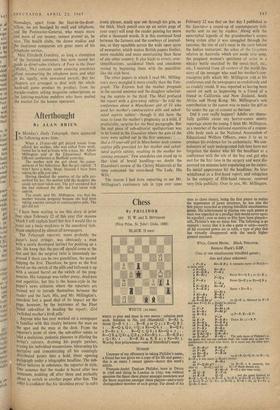Chess
By PHILIDOR 227. H. W. and E. BETTMANN (First Prize, St. ,john's Globe, 1888) BLACK (8 men)
WHITE (to men)
WHITE to play and mate in two moves : solution next week. Solution to No. 226 (Mansfield) : B—Kt 3, threat Q—B 7. z . . . R—K 4 or Q 5 ; 2 R—Q B 7. . . . R--Q 3, Q 2, x q; 2 Kt—Q 6. z R—Q 6 ; 2P—Kt 5...R--Q 7, Q 8 ; 2 Kt—Q 2. i . . . R—Q R 4, Q Kt 4, Q B 4 ; 2 Kt—B 5. z . R—K B 4 ; 2 Qx Kt. . . R—K Kt 4, K R 4 ; 2 Kt—Kt 5. Worthy first prizewinner—one of Mansfield's many.
HOMAGE Unaware of my effrontery in taking Philidor's name, a friend has just given me a copy of his life and games : this is an omen I cannot ignore—hence this week's article.
Francois-Andre Danican Philidor, born at Dreux in 1726 and dying in London in 1795, was without question the finest chess player amongst musicians and the finest musician amongst chess players—and a truly distinguished member of each group. Far ahead of his time in chess theory, being the first player to realise the importance of pawn structure, he was also the first player recorded as playing blindfold simultaneous games. His achievement in playing two such games at once was regarded as a prodigy that would never again be equalled ; now as many as fifty have been played— still, Philidor's was no mean feat. The following is an example ; notice that it is also a game at odds—nearly all his recorded games are at odds, a type of play that has virtually disappeared with the much higher general standard.
White, COMTE BRUHL. Black, PHILMOR. Remove Black's KBP. (One of two simultaneous blindfold games ; date and place unknown) z P—K 4 Kt—K R 3 A favourite move of Philidor's at these odds. a P—Q
3 ,4 Kt—B a
3 B— B4 P—K3 4 B- BOUM- Kt—Q B 3 or Q—K 2.
• • . P—Q 4
5 P—K 5 *P—B 4 Better Q—B 3 or Kt—Q B 3.
5 . .
• • • 7- • •
6 P—Q B 3 Kt—B 3 4 P—K B Better 7 Kt—B 3.
Q—Kt
8 Kt—B3 B-1( a3
9 B—B 2 B--Q a to P—Q Kt 3?. . . to Q—K 2, followed by P x P and then P—Q Kt 4 .p....shoulKdr b4e1 played. to ..x. P P x1P/
rz P B-14 5 ch
n K—B 2
0 B—K 3 13 PxP, KtxK Pl
4554 BBL(KP 3 :P. •P R—xK B 3z Threat Kt (2) xK P.
P—K R
:6 P—K R 4 0-0-0 57 8 Q3 R P—R 3 B—Kt z z9 I—K a : Kt--g a Q R—B z 20 B 3? K—Kt z The only move of PhOidor's in the game that one can perhaps fault. tie could play at once the combination he plays next move. As it turns out, the delay pays him.
at R—R 3? K Ke x PI as PxKt P—Q 3
a3 Kt—B 4 P x B ch 2 Kt x P Q
x P, Q x Q ch ; 25 Kt x Q, .4
B—B 4 is also much in Black's favour. 24 • • • B-8 4 as P—Q Kt 4?? . . . 25 R—K t is essential, but after 25 ... B—Q 5 and 26 . • . Kt xP Black should win. 1,, as . . . . B x Kt ch B—Q 5 also wins easily. RxPch . . . and the game finished 28
Q x Q
I t —22K67 IK42, Otxx R—B Id 5; 29 R — K 4 B—Q , _ Q-11 8L30 Kt—K. t?, Kt—K'a I; 1 R__—_Q 13 4?, Q': Kt; 32 13—Q 3, 11—B 7 ch; 34 K—Kt 3, O—Kt S mate.






























 Previous page
Previous page